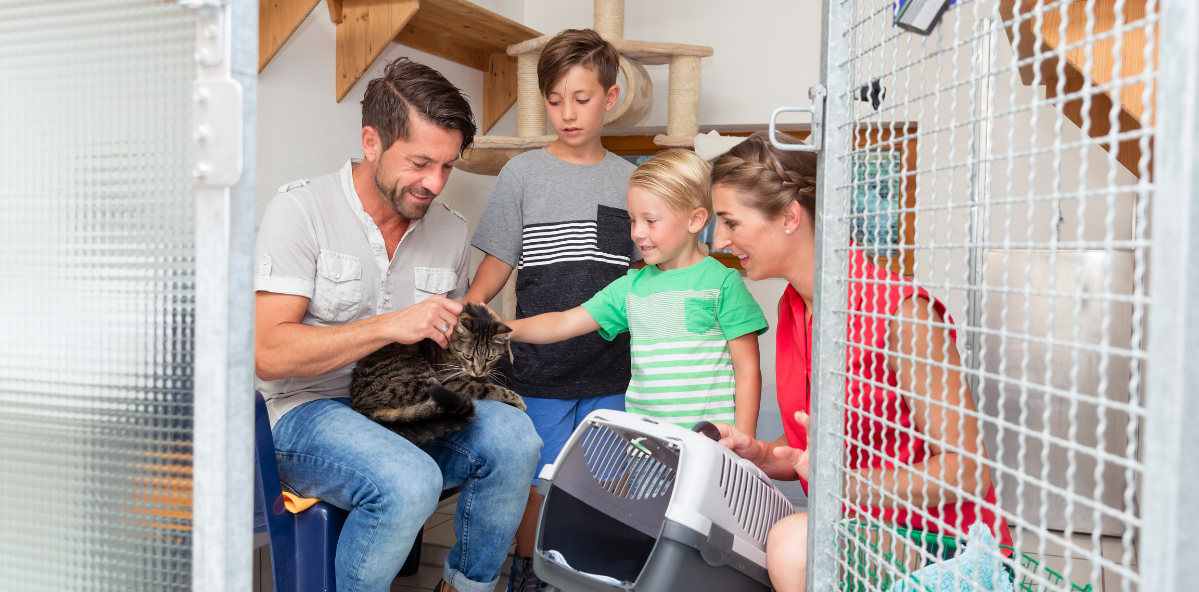
Chances are that if you’re adopting a new cat, you want everything to be just right for your new furry friend. From food choices to scratching posts, you have many different choices to make and it can all feel overwhelming!
While housecleaning and litter box setup probably aren’t the most exciting parts of your pet planning, they’re important for getting your little buddy off on the right foot. Our tips will help you and your cat establish positive litter box routines from the first day.
Every year, thousands of kittens and cats are surrendered due to inappropriate elimination – in other words, peeing and pooping outside the litter box. You’ve likely seen some of these cats during your pet shelter search. In many cases, these unfortunate situations could’ve been prevented if only the pet owner had taken time to determine why their cat wasn’t using the litter box. 
The reality is that you often won’t know your newly adopted cat’s history with litter boxes. Perhaps your cat came from a home where they were chased by the family dog every time they attempted to use the litter box, leading them to find hidden locations to poop or pee. Or your shelter cat may have previously lived outdoors.
In fact, you may know someone who adopted a shelter cat that reportedly had litter box issues yet has done well in their new home. That success is likely due to the efforts of the new pet owner.
Regardless of your new cat’s history, you can take several important steps, outlined below, to ensure litter box success in the future.
Before you bring a new cat home, you’ll want to check your living space for old pet stains and odors. Even if you can’t see these remnants of past messes, your new feline friend will be able to smell them, which may cause stress and inappropriate urination.
Checking carpets, hard flooring, and walls with a blacklight can be useful, especially if you live in an apartment or house that previously had pet residents. Our guide, Using Blacklights to Find Pet Urine, explains how to use a blacklight to find and clean old pet urine stains.
Do you think your home smells like cat pee but can’t find the source of the stink? We recently looked at other sources of cat pee odor – a few may surprise you!
You want your new cat to start with a clean slate, and that means effectively cleaning old pet stains off of carpets and other flooring before bringing a new feline friend into your home.
Dog and cat urine require different cleaning methods than food or drink spills. Fortunately, there are many products on the market today made for just these types of messes.
A good pet stain cleaner should include enzymes and other ingredients designed to break down the urea, uric acid, creatinine, aromatic pheromones, and other chemicals that give dog and cat pee a reputation for being stubbornly stinky. To take it one step further, cleaners like Unique Advanced Cat Odor + Stain combine targeted enzymes with natural bacteria and advanced surfactants to further break down cat messes.
Keep in mind that you’ll also want to eliminate any old dog messes with a product like Unique Advanced Dog Odor + Stain specifically developed for canine urine.
Be sure to read product labels for directions on how to use enzyme- and bacteria-based cleaners to optimize cleaning powder. For example, you may need to leave the product on the stain for a longer period of time, allowing the enzymes and bacteria time to fully break down the pet mess.
Many new pet parents assume that all cats instinctively know how to use a litter box. While it is true that cats will typically seek out a quiet spot to pee or poop and then bury their waste, where they choose to go can be affected by a number of factors, including litter box location and cleanliness and even other household distractions. The last thing you want is for your new cat to decide a clothes pile is the perfect spot!
By making your new cat’s litter box the most attractive, convenient place to do their business, you can help get your little friend off to the right start.

If your new cat ends up peeing or pooping in your closet or someplace other than the litter box, resist the urge to punish them – it’s not effective! Keep in mind that cats often pick the wrong spot due to stress, not out of spite.
Also, don’t assume your cat is doomed to repeat their mistake over and over. One pet accident does not equal a negative behavior pattern but it does mean you should immediately take action to redirect your cat to the litter box:
While most cats will quickly get the hang of their new litter box setup, you may find yourself with a kitty who needs extra help. Check out these seven tips for litter training a cat, including older cats who need to get back into the litter box groove.
As a new pet owner, you’re in for all kinds of fun and cuteness – and sometimes messes! Take the stink in stride by having cleaners onhand that are formulated specifically for pet messes. Check out our Unique Pet line to find the right product for your needs. 


9 Essential Products For Your New Puppy
Life with a new puppy is so exciting.Be ready to welcome them into your home to make the process easier for everyone. It is like bringing a baby home, you must be physically and mentally prepared to make it a joyful experience.

If you're a cat lover, then you know that one of the downsides of having a feline friend is dealing with the litter box. While cats are relatively clean animals, cat urine and waste can produce an unpleasant odor that can be tough to get rid of.
If you're looking for ways to control the litter box smell in your home, check out these top tips.